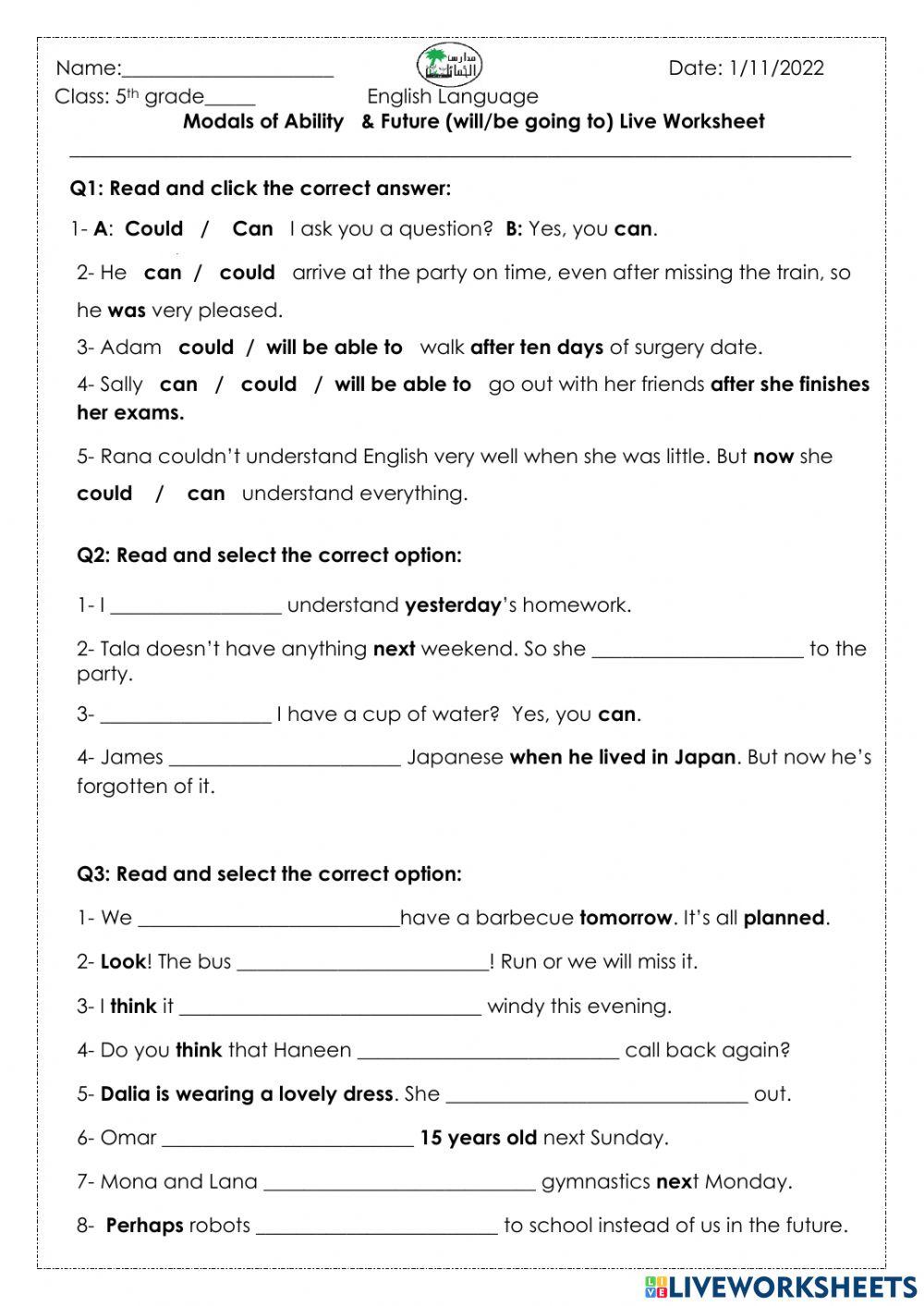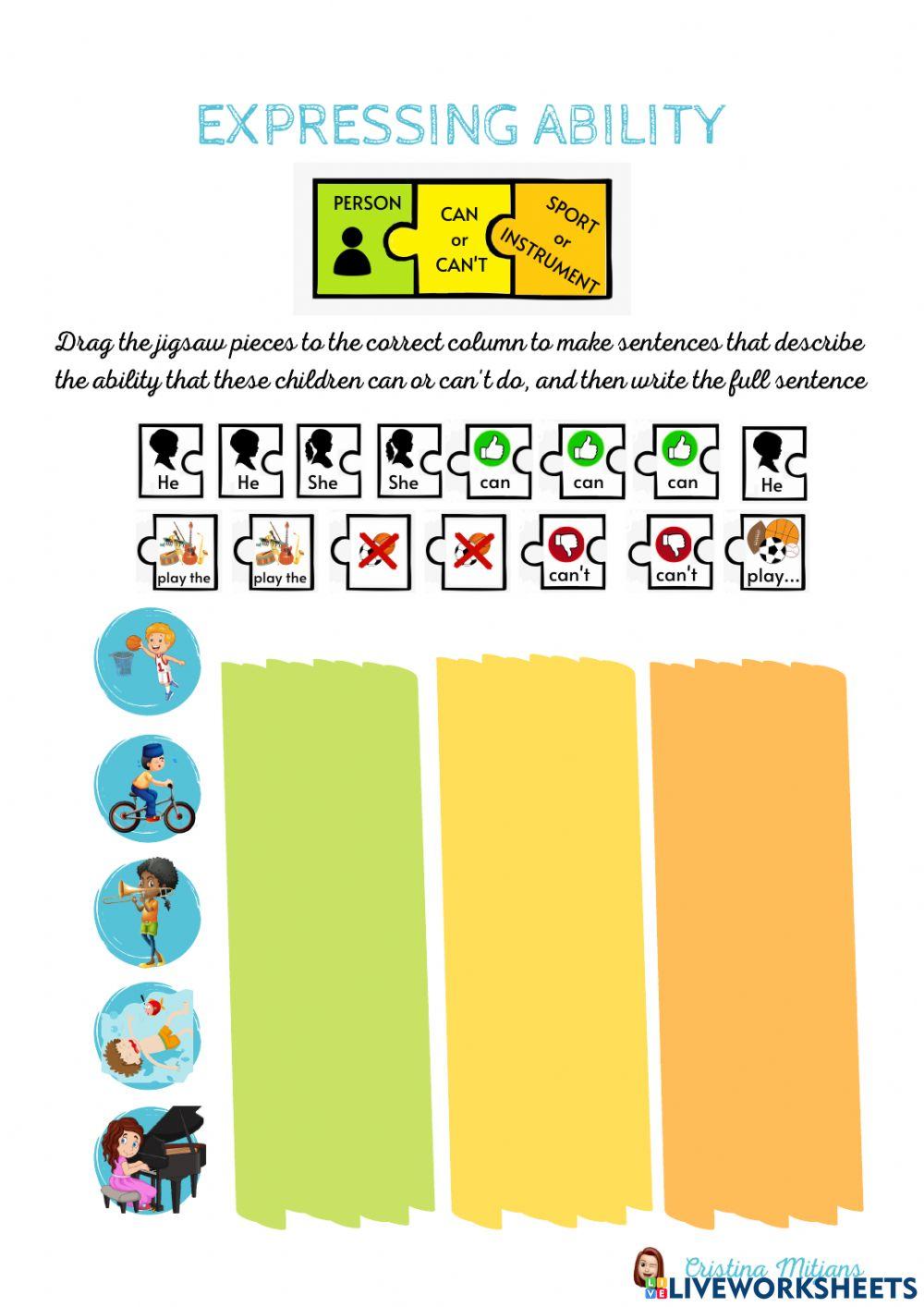
Unlocking Tomorrow: The Transformative Power of Future Ability Worksheets in Language Learning
The ability to discuss the future is a cornerstone of effective communication. Whether planning a career, making travel arrangements, or simply speculating about tomorrow’s weather, our capacity to articulate future events, intentions, and especially future abilities, is indispensable. For language learners, mastering this facet of communication can be particularly challenging, requiring a nuanced understanding of various grammatical structures and lexical items. This is precisely where future ability worksheets emerge as an invaluable pedagogical tool, offering structured, engaging, and comprehensive practice that transcends mere rote memorization.
This article delves into the profound impact of future ability worksheets, exploring their design, diverse applications, and the myriad benefits they offer to both educators and students on their journey towards linguistic fluency.
What Exactly Are Future Ability Worksheets?

At its core, a future ability worksheet is a pedagogical resource designed to help language learners understand, practice, and apply the grammatical structures used to express skills, capabilities, and possibilities that will exist or be acquired in the future. Unlike general future tense worksheets that might focus on predictions or plans (e.g., using "will" or "be going to"), future ability worksheets specifically target expressions like:

- "Will be able to": To express a future capability (e.g., "After I finish this course, I will be able to speak French fluently.").
- "Can" (in future contexts, often with "when" clauses): To express a present ability that will be used in the future (e.g., "When I get home, I can finally relax."). While "can" primarily denotes present ability, its use in conditional future clauses is common.
- "Could" (for future possibility or conditional ability): "If I save enough money, I could travel the world next year."
- "May/Might be able to": To express a less certain future ability or possibility (e.g., "I might be able to join you for dinner if I finish work early.").
- "Be capable of" (in future contexts): Often more formal, expressing an inherent capacity (e.g., "The new software will be capable of processing data much faster.").



These worksheets move beyond simple verb conjugation to contextualize these structures, ensuring learners grasp not just the form but also the function and appropriate usage in real-world scenarios.

Why Are Future Ability Worksheets Indispensable for Language Mastery?
The significance of future ability worksheets extends far beyond mere grammar drills. They serve as a critical bridge between theoretical knowledge and practical application, fostering several key learning outcomes:

- Grammar Accuracy and Fluency: Consistent practice with diverse exercises helps solidify understanding of complex structures like "will be able to," preventing common errors and promoting more natural, fluent expression. Learners become more confident in constructing sentences that precisely convey future capabilities.
- Vocabulary Expansion: These worksheets often integrate topic-specific vocabulary related to future plans, careers, personal development, or technological advancements. For instance, a worksheet on future jobs might introduce terms like "coding," "robotics," or "sustainable energy," enriching the learner’s lexicon.
- Critical Thinking and Predictive Skills: Activities that require students to predict future abilities based on current actions or hypothetical scenarios encourage analytical thinking. For example, "If you study diligently for a year, what skills will you be able to acquire?" prompts students to connect cause and effect.
- Real-World Relevance and Application: Discussing future abilities is inherently practical. These worksheets provide a safe space to practice conversations about career goals, personal development, travel plans, and technological progress. This direct relevance motivates learners by demonstrating the immediate utility of the language.
- Confidence Building: As students successfully complete tasks and articulate their future aspirations or predictions, their confidence in using the target language grows significantly. This positive reinforcement is crucial for continued motivation and progress.
- Scaffolding for Complex Communication: Mastering future ability expressions lays the groundwork for more complex discussions, such as debates about future societal challenges, ethical considerations of new technologies, or long-term strategic planning in professional contexts.


Diverse Activities for Engaging Future Ability Worksheets
To be truly effective, future ability worksheets must incorporate a variety of activity types that cater to different learning styles and levels of proficiency. Here are some examples:
- Fill-in-the-Blanks: The most common type, where students complete sentences with the correct future ability phrase.
- Example: "After graduating, I ___ (be able to / speak) fluent Spanish."
- Sentence Completion: Providing a sentence stem and asking students to complete it, often creatively.
- Example: "In five years, I hope I will be able to ___."
- Matching Exercises: Pairing a situation with the appropriate future ability statement.
- Example: "Situation: Learn to code. Match: You will be able to build websites."
- Transformation Drills: Converting sentences from one tense or structure to a future ability statement.
- Example: "He can swim now. (Future ability): Next year, he will be able to swim across the lake."
- Role-Playing Scenarios: Students act out dialogues where they discuss future plans, job interviews, or personal development goals, requiring them to use future ability expressions naturally.
- Example: A job interview where the interviewer asks, "What new skills do you hope you will be able to develop in this role?"
- Picture Prompts: Showing an image and asking students to predict what the people in the picture will be able to do in the future.
- Debates and Discussions: Presenting a topic (e.g., "The future of work," "How technology will change our lives") and having students express their opinions using future ability language.
- Creative Writing Prompts: Asking students to write about their future selves, a day in 2050, or a futuristic invention, emphasizing the abilities involved.
- Error Correction: Presenting sentences with common errors related to future ability expressions and asking students to identify and correct them. This hones their self-editing skills.
- Surveys/Interviews: Students interview classmates about their future aspirations, such as "What new language do you hope you will be able to speak?" or "What skill do you want to be able to master?"
Designing Effective Future Ability Worksheets
Creating high-quality future ability worksheets requires thoughtful consideration of several pedagogical principles:
- Clear Learning Objectives: Each worksheet should have a specific grammatical or communicative goal. Is it to practice "will be able to" for general future ability, or "may be able to" for possibility?
- Contextual Relevance: Activities should be embedded in realistic and engaging contexts that resonate with learners’ experiences or interests. Topics like travel, careers, technology, personal growth, or environmental issues can be highly motivating.
- Varied Difficulty Levels: Incorporate exercises that cater to different proficiency levels within a class, offering both simpler drills and more complex communicative tasks.
- Clear Instructions: Instructions should be concise, unambiguous, and ideally include an example.
- Visual Appeal: Well-designed layouts, appropriate use of images, and ample space for answers can significantly enhance engagement and readability.
- Authentic Language: Use natural-sounding language and avoid overly academic or stilted phrasing.
- Answer Keys: For self-study or quick teacher checks, an answer key can be incredibly useful, especially for closed-ended exercises.
- Opportunities for Personalization: Whenever possible, include prompts that allow students to express their own ideas, experiences, and future aspirations. This makes the learning more meaningful.
Integrating Technology with Future Ability Worksheets
The digital age offers exciting opportunities to enhance traditional future ability worksheets. Online platforms can transform static pages into dynamic, interactive learning experiences:
- Interactive Worksheets: Websites and apps allow for drag-and-drop exercises, clickable answers, instant feedback, and gamified elements.
- Multimedia Integration: Worksheets can incorporate audio clips (e.g., a dialogue about future plans) or video segments (e.g., a documentary about future technology) as prompts for discussion and ability expression.
- Collaborative Tools: Online whiteboards or document sharing platforms enable students to work together on future ability scenarios, fostering peer learning and communication.
- AI-Powered Tools: AI can generate personalized exercises, provide instant grammatical feedback, or even simulate conversations where students practice discussing future abilities.
- Virtual Reality/Augmented Reality: Imagine a VR scenario where students are "interviewed" for a future job, requiring them to articulate their future skills and capabilities.
Best Practices for Implementation
Simply handing out future ability worksheets is not enough. Effective implementation involves a thoughtful teaching approach:
- Pre-teaching and Review: Before tackling the worksheet, ensure students have a foundational understanding of the target grammar structures. A brief review or mini-lesson can be very beneficial.
- Guided Practice: Start with simpler exercises, guiding students through the first few examples to ensure they understand the task.
- Pair and Group Work: Encourage collaboration. Students can discuss answers, role-play scenarios, or even create their own future ability questions for each other. This promotes peer learning and reduces inhibition.
- Feedback and Correction: Provide constructive feedback. Focus on understanding errors rather than just marking them wrong. Encourage self-correction.
- Follow-Up Activities: Extend the learning beyond the worksheet. Encourage students to use the newly acquired structures in free-form speaking or writing activities.
- Connect to Real-Life: Always draw connections between the worksheet content and how students can use these structures in their daily lives or future endeavors.
Conclusion
In the dynamic landscape of language education, future ability worksheets stand out as an indispensable tool for equipping learners with the linguistic prowess to navigate tomorrow. By providing structured yet flexible practice in expressing future capabilities, possibilities, and intentions, these worksheets do more than just teach grammar; they empower students to envision, plan, and articulate their own futures. From foundational drills to creative communicative tasks, their versatility ensures that learners of all levels can build confidence, expand their vocabulary, and ultimately achieve a more profound and authentic level of communicative competence. As educators, embracing and strategically utilizing these worksheets is a pivotal step in preparing our students not just for language proficiency, but for the exciting possibilities that lie ahead.
